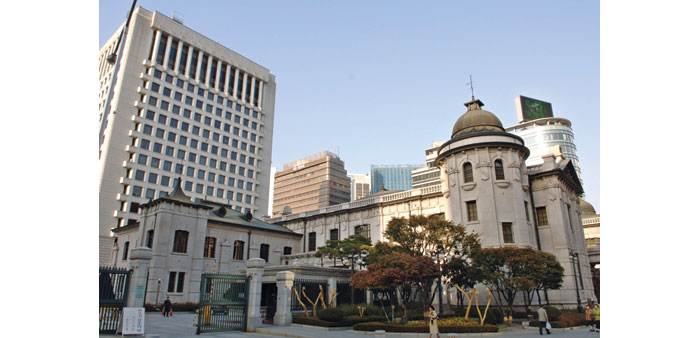Pedestrians walk past in front of Bank of Korea’s headquarters in Seoul. The BoK said yesterday it was setting its new three-year inflation target at 2%, scrapping its current policy of using a targeted band for consumer prices.
Reuters
Seoul
South Korean authorities set a new consumer price target and cut economic growth estimates yesterday, as falling oil prices and weak global growth pose greater risks for the economy.
The Bank of Korea (BoK) said it was setting its new three-year inflation target at 2%, scrapping its current policy of using a targeted band for consumer prices, currently at 2.5 to 3.5%, to lift the economy from low inflation.
The Ministry of Strategy and Finance separately cut its growth estimates for 2015 and 2016, with exports expected to remain stagnant while high household debt and an ageing workforce undermine improvements in consumer spending.
It forecast the economy would grow by a real 3.1% next year, down from 3.3% estimated earlier and also revised this year’s growth to 2.7% from 3.1%.
“The takeaway from the government and central bank’s announcements today is that they will maintain their stance to keep the economy buoyed while continuing structural reform,” said Yoon Yeo-sam, a fixed-income analyst at Daewoo Securities, who sees rates being cut early next year.
Before the current inflation target, South Korea used a midpoint of 3.0% within a range of 2.0 to 4.0%.
Economists at Australia and New Zealand Banking Group said the central bank was “serious about combating deflation,” while forecasting two interest rate cuts next year.
Finance Minister Choi Kyung-hwan said he expected the BoK to manage monetary policy at the level at which it would work to keep inflation near the central bank’s new target. South Korea’s current policy rate is at a record-low of 1.50% after the central bank lowered it in four 25-basis-point steps from 2014, cutting them most recently in June.
Analysts are split between no change for a prolonged period of time and another rate cut in early 2016.
A BoK official told a news conference the new target did not mean interest rates were going to be synced with inflation. Headline inflation has remained far below the bottom end of the current band for most of the target’s existence, sparking criticism from lawmakers and local media.
The 2-percent target number was set as underlying inflation had eased to around 2% since 2012 due to structural economic changes. The headline consumer price index (CPI), which the central bank’s current and next target is based upon, is expected to remain below the new target next year but rise to around 2% in 2017 through 2018, the BoK said.
The finance ministry sees consumption sending inflation to 1.5% next year, up from 1.3% estimated earlier.
Consumer sentiment may continue to pick up, but South Korea faces risks from a shrinking workforce that is also ageing rapidly. The economically-active population is expected to peak next year and start falling in 2017.
South Korean households’ real average propensity to consume, a measure of how much of their income they spend on goods and services, last year fell to its lowest percentage since 1998, according to Statistics Korea.
Growing household debt may also restrict spending power next year, especially if interest rates start creeping up when US rates start to rise.



